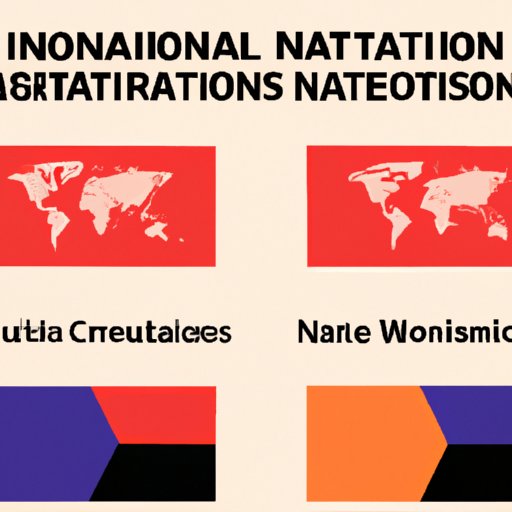Nationalizing: The Ins and Outs of Government Control and Ownership
“Nationalization has always been and will always be a source of debate. It’s not just about who owns what, but how much control a country should have over its industries and resources. Understanding the pros and cons of nationalization is crucial for anyone involved in politics, economy, and society. This article aims to provide a comprehensive guide to nationalization, from its definition and history to its different forms and impacts. Whether you’re a policymaker, investor, or concerned citizen, you’ll find valuable insights and perspectives on one of the most controversial topics in the world.
Understanding Nationalization: A Guide to Government Control and Ownership
Nationalization is the process of transferring ownership and control of assets from private entities to the government. This can occur in various ways, such as through expropriation, confiscation, or national emergency, and can range from partial to complete, permanent to temporary, depending on the situation and the country’s legal framework.
Nationalization has been around for centuries, and its motivation and justification have varied depending on the political and economic context. Some argue that nationalization is necessary to protect national interest, ensure public control, promote equality, and reduce dependency on foreign capital. Others claim that nationalization is a violation of property rights, undermines market efficiency, creates bureaucracy and inefficiency, and discourages innovation and competition.
Common industries that are nationalized include oil and gas, mining, utilities (water, energy, and telecommunications), transportation, and banking. Nationalization can be undertaken for various reasons, such as to increase government revenue, stabilize prices, promote social welfare, and reduce foreign influence.
The Pros and Cons of Nationalizing Industries: Exploring the Possible Impacts
Like any economic policy, nationalization has its pros and cons. Some of the advantages of nationalization include:
- Public Control: Nationalized industries are controlled by the government, which represents the interests of the people. This can ensure that the industry functions in a way that benefits the public rather than just a few shareholders or executives.
- Increased Accountability: Nationalized industries are subject to more transparency and oversight, which can reduce corruption and misconduct. Citizens can also hold the government accountable for the industry’s performance and address their concerns through democratic channels.
- Equity: Nationalization can promote social and economic equality by ensuring that resources are distributed fairly and that everyone has access to essential goods and services.
However, nationalization also has its disadvantages:
- Costs: Nationalization can be expensive as the government needs to compensate previous private owners for their assets. The government also needs to provide funding and resources to run the industry, which can result in budget deficits and other financial issues.
- Bureaucracy: Nationalized industries can become more bureaucratic and slower to adapt to changing market conditions and consumer demand. This can result in unresponsive and inefficient services.
- Inefficiency: Nationalized industries can become less efficient as they lack market competition and incentives for innovation and productivity. This can lead to low-quality products, wasted resources, and lower economic growth.
There have been various cases where nationalization attempts were either successful or unsuccessful. For instance, Venezuela’s nationalization of the oil industry in the 2000s was successful in generating more revenue for the government, but it also resulted in corruption, mismanagement, and declining production. In contrast, Norway’s nationalization of the oil industry has been successful in ensuring that the natural resources are used for the benefit of the public and future generations.
Nationalizing vs. Privatizing: An Analysis of Economic Policies
Privatization is the opposite of nationalization, referring to the transfer of ownership and control of state assets to private entities. Privatization has been promoted as a way to increase market efficiency, encourage innovation, and reduce government intervention. However, like nationalization, privatization also has advantages and disadvantages.
Some of the advantages of privatization include:
- Efficiency: Private companies aim to maximize profits and reduce costs, which can result in more efficient and productive services and products.
- Innovation: Private companies have incentives to innovate and introduce new products and services to stay competitive and attract customers.
- Market Competition: Privatization can introduce more competition in the market, which can lead to lower prices, higher quality, and more choice for consumers.
However, privatization also has its disadvantages:
- Inequality: Privatization can create socioeconomic inequality as the benefits of privatization may only be accessible to those who can afford them.
- Monopoly: Privatization can also result in the concentration of market power in the hands of a few companies, which can have negative impacts on consumers, workers, and small businesses.
- Social Responsibility: Private companies may prioritize profits over public interest, and may not adhere to social and environmental standards.
Both nationalization and privatization policies have been implemented in different countries and contexts, with varying degrees of success. For instance, South Africa shifted from nationalization to privatization in the 1990s, resulting in increased foreign investment and white ownership of assets. However, this also reinforced structural inequality and racial tension. In contrast, China has implemented a mixed system of state ownership and market-oriented reforms, which has resulted in rapid economic growth but also corruption, income inequality, and environmental problems.

Nationalization Around the World: Comparing Different Approaches and Outcomes
Nationalization policies vary widely among different countries and regions, reflecting their unique historical, political, and economic contexts. For instance, Latin American countries such as Venezuela, Bolivia, and Ecuador have pursued nationalization policies in response to poverty, inequality, and dependency on foreign capital. In contrast, Northern European countries such as Norway, Sweden, and Finland have nationalized industries such as oil, mining, and forests to ensure sustainable management and equitable distribution of natural resources.
Several Asian countries such as China, India, and Malaysia have implemented nationalization policies as part of their post-colonial development strategy. However, these policies have often resulted in corruption, inefficiency, and skewed distribution of benefits. African countries such as South Africa, Tanzania, and Mozambique have also nationalized industries such as mining, banking, and telecommunications, with mixed results.
The outcomes of nationalization policies depend on various factors, such as the political stability and legitimacy of the government, the effectiveness of the legal system, the level of public participation and oversight, and the global economic conditions. It is also important to note that nationalization is not a one-size-fits-all solution, and its impact may vary depending on the specific industry and context.
Nationalization in the Age of Globalization: Challenging the Dominance of Multinational Corporations
The rise of globalization has presented new challenges and opportunities for nationalization policies. On the one hand, multinational corporations have become more powerful and influential, and can increasingly bypass national regulations and oversight. This has led some countries to reintroduce nationalization policies as a way to protect their resources and industries from foreign exploitation.
On the other hand, globalization has also opened up new avenues for alternative ownership models, such as public-private partnerships, community ownership, and worker cooperatives. These models aim to balance the benefits of market efficiency and innovation with social responsibility and public interest.
The success of nationalization policies in the age of globalization depends on the ability of governments to adapt to changing global economic conditions and to balance national interest with international cooperation. It also requires the involvement and participation of civil society, public institutions, and the private sector.
Conclusion
In conclusion, nationalization is a complex and controversial topic that requires careful consideration and analysis. While nationalization policies can offer various benefits, such as public control and equity, they also have costs and risks, such as inefficiency and bureaucracy. Nationalization policies should be evaluated based on their specific context and industry, and should be designed and implemented with consultation and participation of all relevant stakeholders.
For policymakers, nationalization should be considered as one of many policy options, and should be based on evidence and consultation rather than ideology or political opportunism. For businesses, nationalization can present both opportunities and challenges, and should be explored and evaluated based on their specific context and strategy. For citizens, nationalization policies should be evaluated based on their contribution to social welfare and public interest, and should be subject to democratic oversight and participation.
For further reading, please consult the following sources:
- “Nationalization in the Modern World” by Richard B. Du Boff and Edward S. Herman, 1976.
- “Privatization: A Theoretical Treatment” by David Reisman, 1989.
- “Nationalization and State-owned Enterprises in Africa: A Comparative Analysis” by David Moore and Robert B. Mattes, 2015.
